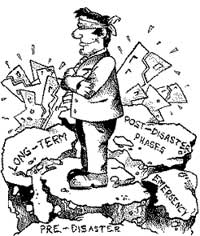Dealing with disasters
 natural disasters are unpredictable, but the way the situation was managed in the recent Gujarat earthquake, for instance, has unearthed many flaws in the existing disaster management system. Unfinished rescue operations, food and water shortage and insufficient medical aid has shown that the country is not geared up to tackle such a calamity. The reason behind this is that India does not have a concrete policy on disaster management. In other words, it is taken as a fire-fighting process and more emphasis is given on developing the emergency response. This only creates more problems in the affected areas.
natural disasters are unpredictable, but the way the situation was managed in the recent Gujarat earthquake, for instance, has unearthed many flaws in the existing disaster management system. Unfinished rescue operations, food and water shortage and insufficient medical aid has shown that the country is not geared up to tackle such a calamity. The reason behind this is that India does not have a concrete policy on disaster management. In other words, it is taken as a fire-fighting process and more emphasis is given on developing the emergency response. This only creates more problems in the affected areas.
Disaster management activity can be divided into pre-disaster, emergency and long-term post-disaster phases, which are inter-independent. Pre-disaster stage activities include preparedness and mitigation in a better and planned manner. The next phase includes rescue and relief operations. The third stage, post-disaster, refers to rehabilitation, which does not only cover rebuilding or repairing houses and roads, but giving crucial importance to the region if it is disaster prone.
For the pre-disaster stage, disaster prone areas need long term planning, which includes preparing hazard zonation maps, land use zoning, modern forecasting and warning systems and creating awareness through education and communication systems. For mitigation, the areas need construction of disaster resistant houses and fortification of old houses in the sensitive zones, rehabilitating people to safer places. In the emergency stage, training people to handle disasters is important. The third post-disaster stage covers four aspects
Related Content
- The future of work in the context of population ageing in Asia and the Pacific
- Climate, community, cooperation: an Indian approach to adaptation in the Global South
- Order of the National Green Tribunal regarding a chemical unit near a residential area in village Chettiar Agaram village, Chennai district, Tamil Nadu, 14/02/2023
- World risk poll 2021: a resilient world?- understanding vulnerability in a changing climate
- Flood management in the country including international water treaties in the field of water resource management with particular reference to treaty/agreement entered into with China, Pakistan and Bhutan
- Two hundred thirty sixth report on action taken by government on the recommendations/observations contained in the two hundred twenty ninth report on the management of COVID-19 pandemic and related issues
